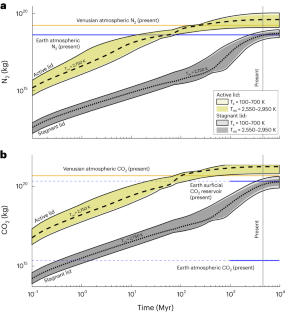2023-10-26 ブラウン大学
◆研究者たちは、金星の大気データとコンピュータモデリングを使用して、現在の大気組成と地表圧力は、初期のプレートテクトニクスの結果であると結論づけました。この発見は、金星が地球と同時期にプレートテクトニクスを経験した可能性があることを示唆し、かつては似ていた2つの惑星が異なる進化の方向に向かう前にどれだけ似ていたかを示しています。この研究は、近くの衛星や遠い太陽系外の惑星についても重要であり、大気が過去の惑星の歴史に関する洞察を提供できることを証明するものです。
<関連情報>
- https://www.brown.edu/news/2023-10-26/venus-plate-tectonics
- https://www.nature.com/articles/s41550-023-02102-w
金星の大気中の窒素は古代のプレートテクトニクスで説明できる Venus’s atmospheric nitrogen explained by ancient plate tectonics
Matthew B. Weller,Alexander J. Evans,Daniel E. Ibarra &Alexandria V. Johnson
Nature Astronomy Published:26 October 2023
DOI:https://doi.org/10.1038/s41550-023-02102-w

Abstract
Venus is the least understood of the terrestrial planets. Despite broad similarities to the Earth in mass and size, Venus has no evidence of plate tectonics recorded on its young surface, and Venus’s atmosphere is strikingly different. Numerical experiments of long-term planetary evolution have sought to understand Venus’s thermal–tectonic history with indeterminate results. However, Venus’s atmosphere is linked to interior evolution and can be used as a diagnostic to constrain planetary evolution. Here we compare the present-day Venusian atmosphere to atmospheres generated by long-term thermal–chemical–tectonic evolution models. We find that a continuous single-plate stagnant lid regime operating since antiquity (magma ocean solidification) explains neither the present-day observed atmospheric abundances of N2 and CO2, nor the surface pressure. Instead, the Venusian atmosphere requires volcanic outgassing in an early phase of plate-tectonic-like activity. Our findings indicate that Venus’s atmosphere results from a great climatic–tectonic transition, from an early phase of active lid tectonics that lasted for at least 1 Gyr, followed by the current stagnant lid-like mode of reduced outgassing rates.



